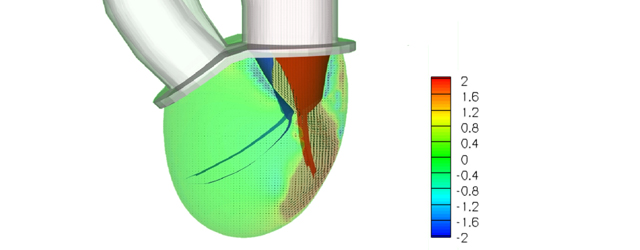Accueil
Relativity Matters: Two opposing views of the magnetic force reconciled (Vol. 49, No. 2)

How magnetic force acts on charged subatomic particles near the speed of light
Current textbooks often refer to the Lorentz-Maxwell force governed by the electric charge. But they rarely refer to the extension of that theory required to explain the magnetic force on a point particle. For elementary particles, such as muons or neutrinos, the magnetic force applied to such charges is unique and immutable. However, unlike the electric charge, the magnetic force strength is not quantised. For the magnetic force to act on them, the magnetic field has to be inhomogeneous. Hence this force is more difficult to understand in the context of particles whose speed is near the speed of light. Moreover, our understanding of how a point-particle carrying a charge moves in presence of an inhomogeneous magnetic field relied until now on two theories that were believed to differ. The first stems from William Gilbert's study of elementary magnetism in 16th century, while the second relies on André-Marie Ampère electric currents. In a new study just published, the authors succeeded in resolving this ambiguity between Amperian and Gilbertian forms of magnetic force. Their solution makes it possible to characterise the interaction of particles whose speed is close to the speed of light in the presence of inhomogeneous electromagnetic fields.
J. Rafelski, M. Formanek, and A. Steinmetz, Relativistic Dynamics of Point Magnetic Moment, Eur. Phys. J. C 78, 6 (2018)
[Abstract]
The unsuspected synergistic mechanism of the human heart (Vol. 49, No. 2)

3D simulations reveals that every part of the human heart works in combination with the others, while all parts influence each other’s dynamics, giving clues to help prevent cardiac conditions.
Did you know that the left side of the heart is the most vulnerable to cardiac problems? Particularly the left ventricle, which has to withstand intense pressure differences, is under the greatest strain. As a result, people often suffer from valve failure or impairment of the myocardium. This is why it is important to fully understand how the blood flow within this part of the heart affects its workings. In a new study the authors introduce a novel model that examines, for the first time with this approach, the mutual interaction of the blood flow with the individual components of the heart. Their work stands out by offering a more holistic and accurate picture of the dynamics of blow flow in the left ventricle. Until now, most cardiac models have considered separate components of the heart, either the ventricle or the mitral valve. But they have never approached the whole combination as a synergistic system. Another key shortcoming of previous models was their failure to take into account either the interaction between the blood and the heart structure, which can lead to deformation of the heart, or the structure of the heart chambers under the load of the passing blood flow. The authors also perform some experimental validations of their model.
V. Meschini, M. D. de Tullio and R. Verzicco, Effects of mitral chordae tendineae on the flow in the left heart ventricle, Eur. Phys. J. E 41, 11634 (2018).
[Abstract]
Quantifying electrocaloric effects in multilayer capacitors (Vol. 49, No. 2)

Multilayer capacitors (MLCs) are now being exploited in prototype cooling devices because they show large voltage-driven changes of temperature that can be used to pump large amounts of heat. However, accurate quantification of these electrically driven temperature changes is challenging because only the core is electrocalorically active.
In a recent study, the authors investigated electrocaloric MLCs with different geometries. By increasing the active volume of the core with respect to the inactive surround, the authors were able to identify the temperature changes that could be driven in the core without thermalization due to the surround. This improves upon previous works, in which partial thermalization was assumed to be complete, leading to overestimates of temperature change.
T. Usui, S. Hirose, A. Ando, S. Crossley, B. Nair, X. Moya, and N. D. Mathur, Effect of inactive volume on thermocouple measurements of electrocaloric temperature change in multilayer capacitors of 0.9Pb(Mg1/3Nb2/3)O3–0.1PbTiO3, J. Phys. D: Appl. Phys. 50, 424002 (2017).
[Abstract]
Biological rhythms—what sets their amplitude? (Vol. 49, No. 2)

Living organisms rely on internal biological timers to ensure their proper development and functioning during adult life; examples are the formation of repetitive embryonic patterns or the entrainment of activity cycles to the day-night cycle. Such timers are typically embodied as biochemical oscillators, i.e., genetic regulatory networks that generate oscillations in the concentration of gene products within cells via a delayed negative feedback. Theoretical descriptions of these oscillators often rely on nonlinear rate equations that describe how the interactions between different gene products can give rise to stable limit-cycle oscillations. For a large class of such models, we here derive a method to construct analytical bounds for the minima and maxima of the oscillations, one of their functional key features besides their period. Numerical simulations of different example systems show that the oscillations saturate the bounds as the feedback delay becomes large. The results shed light on which details of the nonlinear feedback are responsible for constraining the oscillation amplitude and can be readily generalised to similar oscillator systems.
D. J. Jörg, Amplitude bounds for for biochemical oscillators, EPL 119, 58004 (2017)
[Abstract]







